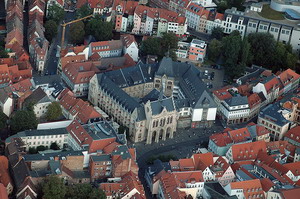| Germany
Travel Guide
Thüringen
Travel Information
The Free
State of Thuringia (German: Freistaat Thüringen) is located
in central Germany.
It has an area of 16,171 square
kilometers (6,243.7 sq mi) and 2.29 million inhabitants, making it the
sixth smallest by area and the fifth smallest by population of Germany's
sixteen Bundesländer (federal states). The capital is Erfurt.
 Thuringia
borders on (from the northwest and clockwise) the German states of Lower
Saxony, Saxony-Anhalt, Saxony,
Bavaria
and Hesse. The ridges of
the western Harz Mountains divide the region from Lower Saxony on the north-west,
while the eastern Harz similarly separates Thuringia from the state of
Saxony-Anhalt to the north-east. To the south and southwest, the Thuringian
Forest effectively separates the ancient region of Franconia, now the northern
part of Bavaria, from the rolling plains of most of Thuringia. The central
Harz range extends southwards along the western side into the northwest
corner of the Thuringian Forest region, making Thuringia a lowland basin
of rolling plains nearly surrounded by ancient somewhat-difficult mountains.
To the west across the mountains and south is the drainage basin of the
Rhine River. Thuringia
borders on (from the northwest and clockwise) the German states of Lower
Saxony, Saxony-Anhalt, Saxony,
Bavaria
and Hesse. The ridges of
the western Harz Mountains divide the region from Lower Saxony on the north-west,
while the eastern Harz similarly separates Thuringia from the state of
Saxony-Anhalt to the north-east. To the south and southwest, the Thuringian
Forest effectively separates the ancient region of Franconia, now the northern
part of Bavaria, from the rolling plains of most of Thuringia. The central
Harz range extends southwards along the western side into the northwest
corner of the Thuringian Forest region, making Thuringia a lowland basin
of rolling plains nearly surrounded by ancient somewhat-difficult mountains.
To the west across the mountains and south is the drainage basin of the
Rhine River.
The most conspicuous geographical
feature of Thuringia is the Thuringian Forest, a mountain chain in the
southwest. The Werra River, a tributary of the Weser River, separates this
mountain chain from the volcanic Rhön Mountains, which are partially
in Thuringia, Bavaria,
and Hesse. In the northwest,
Thuringia includes a small part of the Harz. The eastern part of Thuringia
is generally a plain. The Saale River runs through these lowlands from
south to north.
The geographic center of
the Federal Republic is located in Thuringia, near the municipality of
Niederdorla.
read
more |

